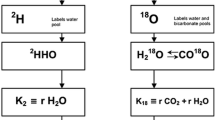Abstract
Two men, R.F. and M.S., pulled sledges each with starting masses of 222 kg, 2300 km across Antarctica. Exercise was performed for approximately 10 h each day for 95 days. Despite an average energy intake of 21.3 MJ · day−1 both subjects lost more than 25% of body weight. Energy expenditure was measured using energy balance data (EB) and isotope-labelled water (2H2 18O). Isotope doses were taken on day 0 and day 50 of the expedition. During the first 50 days both methods gave reasonable agreement, giving energy expenditures of 38.3 (EB) and 35.5 (2H2 18O) MJ · day−1 in R.F. and 28.6 (EB) and 29.1 (2H2 18O) MJ · day−1 in M.S. The isotope data for days 20–30 yielded exceptional values of 44.6 MJ · day−1 in R.F. and 48.7 MJ · day−1 in M.S. Estimates of energy expenditure between day 51 and day 96 were much lower and although the methods were in agreement for R.F. – 24.1 (EB) and 23.1 (2H2 18O) MJ · day−1, there was poor agreement for MS – 26.8 (EB) and 18.8 (2H2 18O) MJ · day−1. However, some practical difficulties occurred during this second period and there were also problems arising from marked increases in body water that made estimates of body mass and composition change difficult to interpret. The latter problems were probably due to malnutrition, which may have also been responsible for surprising increases in urinary excretion of 2H and 18O observed in both men at around day 81. These increases may reflect the release of label incorporated into molecules other than water which do not normally freely exchange with the body water pool under the circumstances of marked malnourishment. Following the expedition, both men showed declines in maximal O2 consumption (V˙O2 max , 53.6 to 41.2 ml O2 kg−1 · min−1 in R.F., 58.1–46.0 ml O2 kg−1 · min−1 in M.S.); maximal voluntary isometric force production in different muscle groups (up to 19.9% in R.F. and 55.8% in M.S.) and both cytoplasmic and mitochondrial skeletal muscle enzyme activities (up to 56% in R.F. and 63% in M.S.). Plasma samples taken during the expedition showed low glucose levels, inappropriately high insulin levels, and declines in testosterone and luteinizing hormone. Thyroxine, cholesterol, albumin and triglyceride levels remained normal.
Similar content being viewed by others
Author information
Authors and Affiliations
Additional information
Accepted: 15 February 1997
Rights and permissions
About this article
Cite this article
Stroud, M., Ritz, P., Coward, W. et al. Energy expenditure using isotope-labelled water (2H2 18O), exercise performance, skeletal muscle enzyme activities and plasma biochemical parameters in humans during 95 days of endurance exercise with inadequate energy intake. Eur J Appl Physiol 76, 243–252 (1997). https://doi.org/10.1007/s004210050243
Issue Date:
DOI: https://doi.org/10.1007/s004210050243




